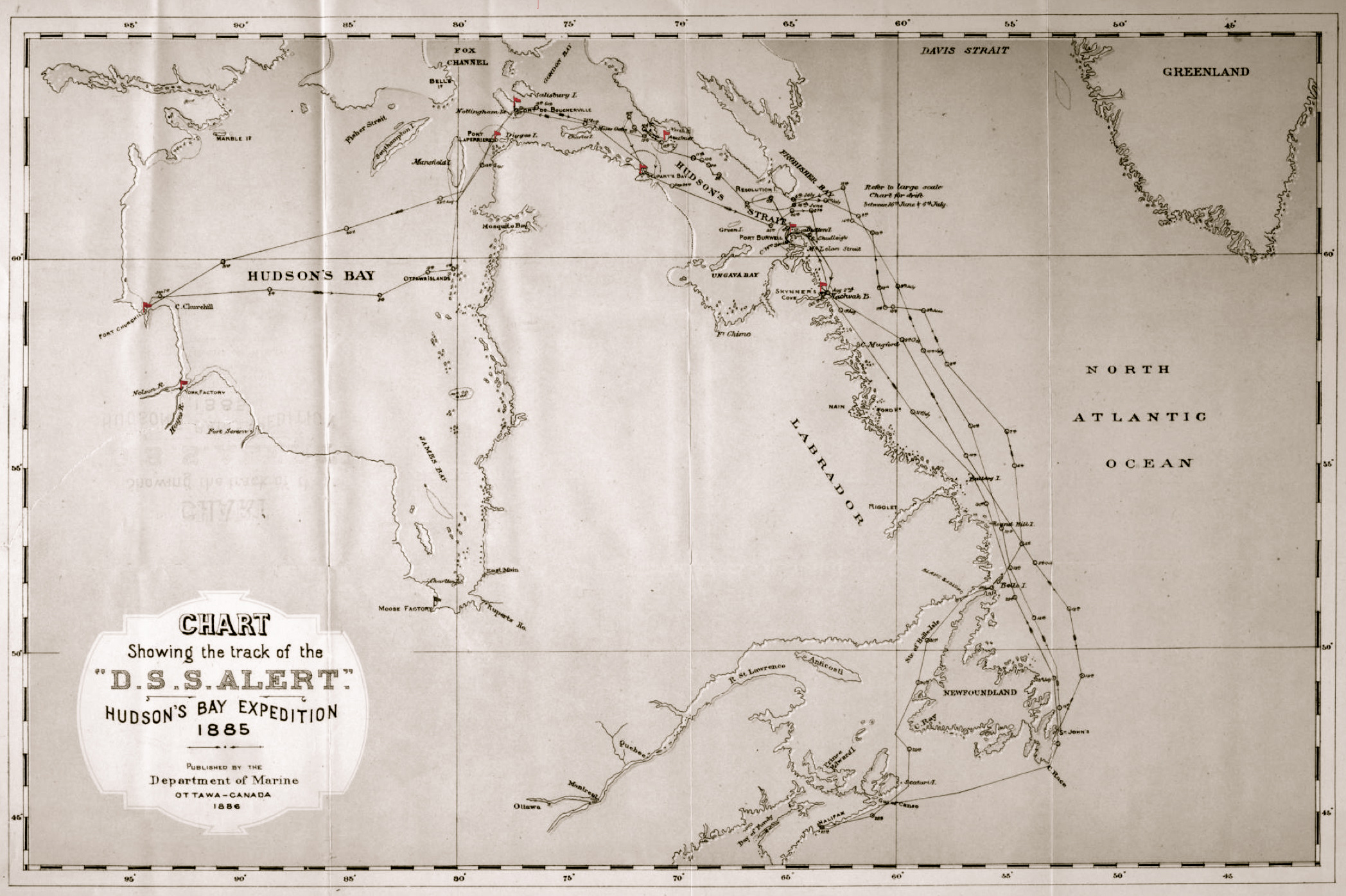
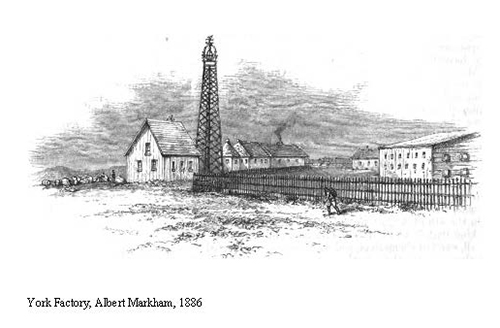 York Factory was a much larger and more imposing post than the one at Churchill. It even had two small churches: one inside the Hudson’s Bay Company stockade, and the other outside the post, built by the missionaries for the local Cree people. Mr. Wood, the storekeeper, had carried out meteorological observations for several years. Gordon checked his instruments and records, and found all “well done.”
York Factory was a much larger and more imposing post than the one at Churchill. It even had two small churches: one inside the Hudson’s Bay Company stockade, and the other outside the post, built by the missionaries for the local Cree people. Mr. Wood, the storekeeper, had carried out meteorological observations for several years. Gordon checked his instruments and records, and found all “well done.”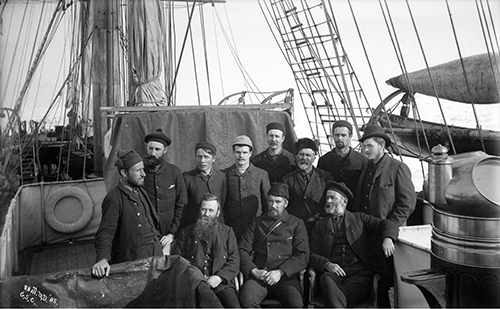 Fort Churchill had been a Hudson’s Bay Company fur trading post since 1717. The population in 1884 was 40. Charles Tuttle, the 36-year-old journalist accompanying the voyage was supposed to take up residence in the already established Churchill to conduct meteorological studies, but bowed out of the task when the expedition arrived at Churchill, claiming ill health. The Hudson’s Bay Company Chief Factor Spencer ended up accepting the job for $120 a year. [Robert Bell, LAC C-052196]
Fort Churchill had been a Hudson’s Bay Company fur trading post since 1717. The population in 1884 was 40. Charles Tuttle, the 36-year-old journalist accompanying the voyage was supposed to take up residence in the already established Churchill to conduct meteorological studies, but bowed out of the task when the expedition arrived at Churchill, claiming ill health. The Hudson’s Bay Company Chief Factor Spencer ended up accepting the job for $120 a year. [Robert Bell, LAC C-052196]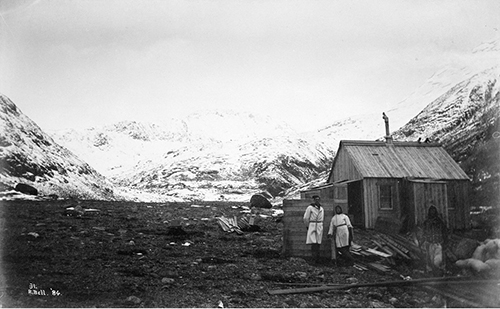 The Skynner’s Cove station was originally planned for Resolution Island on the north side of Hudson Strait, but the island’s coastline was unapproachable. This station was the last one erected on September 30, 1884, and named after its head observer William Skynner. B.M. Rainsford and W.H. Jordan were his assistants. The Skynner’s Cove station was only in use from September 1884 to September 1885. It was sold to the Hudson’s Bay Company at Nachvak Fiord on September 30, 1886.[Robert Bell, LAC C-086357]
The Skynner’s Cove station was originally planned for Resolution Island on the north side of Hudson Strait, but the island’s coastline was unapproachable. This station was the last one erected on September 30, 1884, and named after its head observer William Skynner. B.M. Rainsford and W.H. Jordan were his assistants. The Skynner’s Cove station was only in use from September 1884 to September 1885. It was sold to the Hudson’s Bay Company at Nachvak Fiord on September 30, 1886.[Robert Bell, LAC C-086357]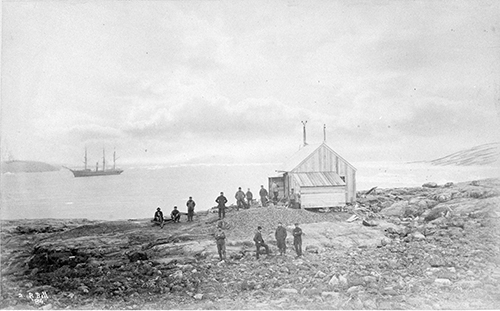 Port Laperrière was erected on August 24, 1884, and named for its head observer Arthur Laperrière. His companions were W.S. Quigley and Adam Maher. Mr. Robert Youill was initially supposed to be one of the station men but as he was in ill health, Gordon appointed the carpenter, Quigley, to take his place. In the summer of 1885, the observer was Percy Woodworth, and the station hands were A.R. Bissette and J. Bowditch. These men returned south with the Alert at the end of the summer of 1886. The station was dismantled in September 1886 and all building materials and remaining supplies were taken on board the Alert and returned to Halifax. [Robert Bell, LAC C-086359]
Port Laperrière was erected on August 24, 1884, and named for its head observer Arthur Laperrière. His companions were W.S. Quigley and Adam Maher. Mr. Robert Youill was initially supposed to be one of the station men but as he was in ill health, Gordon appointed the carpenter, Quigley, to take his place. In the summer of 1885, the observer was Percy Woodworth, and the station hands were A.R. Bissette and J. Bowditch. These men returned south with the Alert at the end of the summer of 1886. The station was dismantled in September 1886 and all building materials and remaining supplies were taken on board the Alert and returned to Halifax. [Robert Bell, LAC C-086359]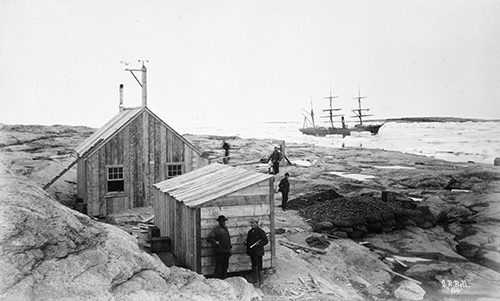 Port de Boucherville, erected on August 24, 1884, was named for its head observer C.V. De Boucherville. His station men were Andrew D. Inglis and W.F. Esdaile. When the Alert arrived on August 24, 1885, the expedition men discovered that Andrew Inglis had died of scurvy earlier that summer. In 1885, the observer was John McKenzie, and the station hands were Maurice Fleming and G.P. Gooley. These men returned south with the Alert at the end of the summer of 1886. The Port De Boucherville station was dismantled in September 1886, and all building materials and remaining supplies were taken on board the Alert and returned to Halifax. [Robert Bell, LAC C-086362]
Port de Boucherville, erected on August 24, 1884, was named for its head observer C.V. De Boucherville. His station men were Andrew D. Inglis and W.F. Esdaile. When the Alert arrived on August 24, 1885, the expedition men discovered that Andrew Inglis had died of scurvy earlier that summer. In 1885, the observer was John McKenzie, and the station hands were Maurice Fleming and G.P. Gooley. These men returned south with the Alert at the end of the summer of 1886. The Port De Boucherville station was dismantled in September 1886, and all building materials and remaining supplies were taken on board the Alert and returned to Halifax. [Robert Bell, LAC C-086362]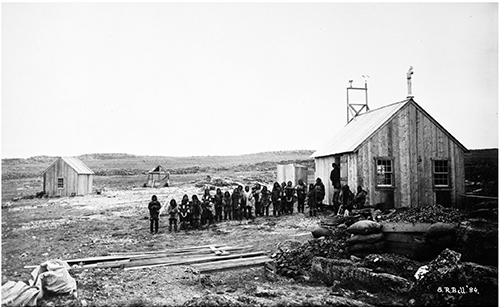 Stupart Bay was erected on August 17, 1884, and named after the head observer 27-year-old Robert Frederick Stupart. Because additional magnetical observations were to be taken at this station, two extra buildings were erected and Harry T. Bennett, a second observer, was assigned to assist Stupart. John W. Chaplain and John W. McDaniel were the other station men. This was the only station with four men, although no allowance was made for extra provisions.The winter of 1884-85 was exceptionally severe at Stupart Bay and 18 of the local people starved to death. In August 1885, concerned that that summer’s expedition ship wouldn’t arrive, Stupart, Bennet, Chaplain and McDaniel left the station in an open boat and headed to Fort Chimo 300 miles away. The Alert arrived a day after they left and three men took their place at the station. F. F. Payne was the observer and the station hands were Frank Paul and Albert Boutillier. These men returned south with the Alert at the end of the summer of 1886. The Stupart Bay station was dismantled in September 1886 and all building materials and remaining supplies were taken on board the Alert and returned to Halifax. [Robert Bell, LAC C-086377]
Stupart Bay was erected on August 17, 1884, and named after the head observer 27-year-old Robert Frederick Stupart. Because additional magnetical observations were to be taken at this station, two extra buildings were erected and Harry T. Bennett, a second observer, was assigned to assist Stupart. John W. Chaplain and John W. McDaniel were the other station men. This was the only station with four men, although no allowance was made for extra provisions.The winter of 1884-85 was exceptionally severe at Stupart Bay and 18 of the local people starved to death. In August 1885, concerned that that summer’s expedition ship wouldn’t arrive, Stupart, Bennet, Chaplain and McDaniel left the station in an open boat and headed to Fort Chimo 300 miles away. The Alert arrived a day after they left and three men took their place at the station. F. F. Payne was the observer and the station hands were Frank Paul and Albert Boutillier. These men returned south with the Alert at the end of the summer of 1886. The Stupart Bay station was dismantled in September 1886 and all building materials and remaining supplies were taken on board the Alert and returned to Halifax. [Robert Bell, LAC C-086377]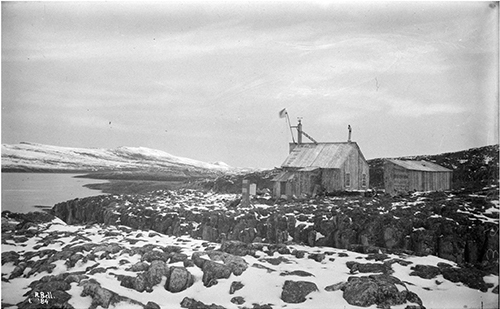 Ashe Inlet was the second observation station established. Erected on August 11, 1884, it was the only one on the north side of Hudson Strait. It was named after William Austin Ashe, the two other station men posted there were M.W. Keating and Fred Drysdale. The Alert failed to get through the ice to the station the first week of August 1885. When it returned in September, it was to discover that William Ashe was suffering acutely from scurvy. He recovered after being taken aboard and receiving medical attention. In 1885, Ashe, Keating and Drysdale were replaced by three other men for the next year. The 1885 observer was 22-year-old James W. Tyrrell, and the station hands were D. Creelman and William Mills. These men returned south with the Alert at the end of the summer of 1886. Ashe Inlet was the only station not dismantled in 1886. [Robert Bell, LAC C-052128]
Ashe Inlet was the second observation station established. Erected on August 11, 1884, it was the only one on the north side of Hudson Strait. It was named after William Austin Ashe, the two other station men posted there were M.W. Keating and Fred Drysdale. The Alert failed to get through the ice to the station the first week of August 1885. When it returned in September, it was to discover that William Ashe was suffering acutely from scurvy. He recovered after being taken aboard and receiving medical attention. In 1885, Ashe, Keating and Drysdale were replaced by three other men for the next year. The 1885 observer was 22-year-old James W. Tyrrell, and the station hands were D. Creelman and William Mills. These men returned south with the Alert at the end of the summer of 1886. Ashe Inlet was the only station not dismantled in 1886. [Robert Bell, LAC C-052128]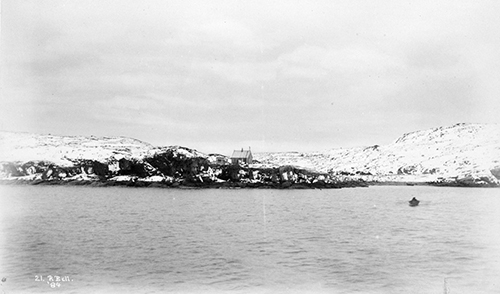 Port Burwell was the first of the six observation stations and was erected on August 5, 1884. It was named after the station’s 21-year-old head observer, Herbert Mahlon Burwell. His two assistants were R. Currie and J.E. Campbell. In 1885, Burwell, Currie and Campbell were replaced by three other men for the next year. The observer was Gilbert R. Shaw, and the station hands were brothers, Telesphore Mercier and John Mercier. At the end of the summer of 1886, when the expedition ship Alert arrived to pick the men up, it was discovered that Shaw was suffering from scurvy. He had refused to drink the lime juice provided to each station. However, he recovered with medical attention. The Port Burwell station was dismantled in September 1886 and all building materials and remaining supplies were taken on board the Alert and returned to Halifax. [Robert Bell, LAC, C-086358]
Port Burwell was the first of the six observation stations and was erected on August 5, 1884. It was named after the station’s 21-year-old head observer, Herbert Mahlon Burwell. His two assistants were R. Currie and J.E. Campbell. In 1885, Burwell, Currie and Campbell were replaced by three other men for the next year. The observer was Gilbert R. Shaw, and the station hands were brothers, Telesphore Mercier and John Mercier. At the end of the summer of 1886, when the expedition ship Alert arrived to pick the men up, it was discovered that Shaw was suffering from scurvy. He had refused to drink the lime juice provided to each station. However, he recovered with medical attention. The Port Burwell station was dismantled in September 1886 and all building materials and remaining supplies were taken on board the Alert and returned to Halifax. [Robert Bell, LAC, C-086358]